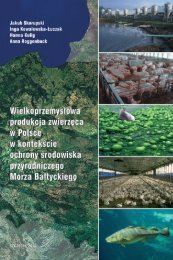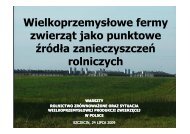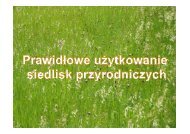best available technologies for manure treatment - Baltic Green Belt
best available technologies for manure treatment - Baltic Green Belt
best available technologies for manure treatment - Baltic Green Belt
You also want an ePaper? Increase the reach of your titles
YUMPU automatically turns print PDFs into web optimized ePapers that Google loves.
Best Available Technologies <strong>for</strong> <strong>manure</strong> <strong>treatment</strong> baltic sea 2020<br />
ANNEX K: KEY ELEMENTS OF DANISH LEGISLATION IN RELATION TO N AND P LEACHING<br />
by 2015. The goals shall be reached <strong>for</strong> instance via<br />
the establishing of more buffer strips along streams.<br />
Additionally, the plan includes the goal of having at<br />
least 50% of all livestock <strong>manure</strong>s treated <strong>for</strong> energy<br />
purposes by 2020, and mention that principally all<br />
livestock <strong>manure</strong>s should be treated in the future.<br />
Concrete legislation<br />
The current legislation in Denmark to implement the<br />
provisions of EU’s Nitrates Directive is found in<br />
• Lovbekendtgørelse nr. 757 af 29. juni 2006<br />
om jordbrugets anvendelse af gødning og om<br />
plantedække (Law about use of fertilisers and<br />
about plant cover)<br />
• Bekendtgørelse om jordbrugets anvendelse af<br />
gødning og om plantedække i planperioden<br />
2008/09 (Regulation about use of fertilisers<br />
and about plant cover <strong>for</strong> the planning period<br />
2008/09)<br />
• Miljøministeriets bekendtgørelse nr. 1695 af 19.<br />
december 2006 om husdyrbrug og dyrehold <strong>for</strong><br />
mere end 3 dyreenheder, husdyrgødning, ensilage<br />
mv. (Regulation about animal husbandry)<br />
• Lov nr. 418 af 26. juni 1998 om afgift af kvælstof<br />
indeholdt i gødninger m.m. (Law about exise<br />
taxation of N in mineral fertiliser)<br />
• Bekendtgørelse nr. 1596 af 19. december 2007<br />
om direkte støtte til landbrugere efter enkeltbetalingsordningen<br />
(Regulation about direct<br />
subsidisation of farmers according the ssingle<br />
payment scheme)<br />
• Bekendtgørelse nr. 345 af 13. maj 2008 om<br />
krydsoverensstemmelse. (Regulation about<br />
cross compliance)<br />
• Bekendtgørelse om kvælstofprognosen <strong>for</strong> 2009,<br />
der udsendes omkring 1. april 2009. (Regulation<br />
about the N prognosis)<br />
The mentioned legislation says <strong>for</strong> instance, that<br />
installations <strong>for</strong> the intensive rearing of pigs must<br />
dispose of 1 ha of agricultural land <strong>for</strong> spreading of<br />
livestock <strong>manure</strong> <strong>for</strong> each 1,4 Animal Units, installations<br />
<strong>for</strong> the intensive rearing of pigs must have 9<br />
months storage capacity <strong>for</strong> livestock <strong>manure</strong>, the<br />
field effect of pig slurry must be at least 75%, there<br />
must be elaborated fertiliser plans according official<br />
fertiliser norms and <strong>manure</strong> standards latest by 21<br />
April, and there must be submitted fertiliser accounts<br />
(in 2010 latest 1 February <strong>for</strong> the previous harvest<br />
year 2008/09).<br />
The Danish Nature Protection Law contains<br />
provisions regarding distances between stables and<br />
watercourses, the quality of the floors in the stables,<br />
etc. The law holds as well the provisions in relation<br />
to the IPPC Directive concerning requirements <strong>for</strong><br />
environmental permitting of intensive livestock farms<br />
– and again Denmark was on the <strong>for</strong>efront with the<br />
requirements, which came already in 1974, 15 years<br />
be<strong>for</strong>e the IPPC Directive was issued by EU.<br />
In 1999 the IPPC Directive was built into the<br />
Nature Protection Law, and it was decided that<br />
intensive livestock farms in Denmark was defined as<br />
farms with more than 250 Animal Units, no matter<br />
whether pigs, poultry or cattle. In 2006 came additionally<br />
a new Law on Approval of Livestock Farms,<br />
which determines, that<br />
• hobby farms (<strong>for</strong> instance 2 cows or 10 sheep)<br />
is under control and shall comply with some soft<br />
environmental regulations;<br />
• small farms with 3–15 animal units shall in<strong>for</strong>m<br />
the authorities of change in livestock production;<br />
• farms with 15–75 animal units (Annex 2) needs<br />
an environmental approval;<br />
• farms with 75–250 animal units (Annex 2) needs<br />
an environmental approval – screening;<br />
• farms with more than 250 animal units<br />
(Annex 1) needs an Environmental Impact<br />
Assessment (EIA) approval; and<br />
• authorities who handle environmental applications<br />
and EIA applications are paid by the applicant.<br />
The Danish Environmental Protection Agency organises<br />
in connection to the environmental permitting<br />
the so-called technology lists, which are the Danish<br />
versions of the BAT’s. The Danish technology lists<br />
are stronger than the BAT’s contained in the BREF<br />
document, as it <strong>for</strong> instance is not allowed to broad<br />
spread slurry in Denmark; it has to be applied with<br />
band laying systems, and in case of bare soils and<br />
grasslands the slurry must be injected.<br />
97








